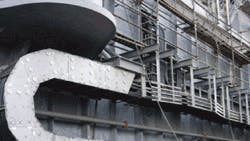Steel cable carriers
Dynamic cable carriers were first introduced in 1954, and originally all were made of steel. More recently, manufacturers began making carriers of glass-fiber-reinforced nylon or nylon-aluminum hybrids — which fit the bill in many applications. However, cable and hose carriers made of steel are not old-fashioned or outdated. In fact, many hot and dirty applications require them: In a myriad of extreme environments requiring resistant designs, steel continues to be the only reasonable and cost-effective option. Therefore, some carrier manufacturers continue to offer steel carriers. These are continually reengineered and upgraded, and some are available in versions customized for specific extreme environments.
Q&A
Where specifically are steel carriers used?
Offshore applications are typical, as carriers made of stainless-steel are highly resistant to seawater and UV exposure. Material reliability and high strength also allow the carriers to withstand mechanical stress from high loads, even over long unsupported travel lengths.
In fact, some larger steel carriers can bear cable and hose weight loads in excess of 500 kg/m over unsupported spans of several meters.
Mining, tunnel drilling, and excavating are other applications: These expose carriers to falling rocks and particulate contamination in the form of dust, sand, and dirt. For these environments, some steel carrier side-band link plates come in various geometric shapes to increase strength and reduce weight. Open style designs and side-band pivots are self-cleaning to minimize wear caused by continuous exposure to contaminants such as sand and dust — which might otherwise get trapped in the carrier's joints.
Steel carriers are also suitable for pick-and-place robots and work-piece manipulators used in acid baths, electroplating plants, nuclear power plants, or other radioactive areas. Although the practice is not recommended, steel cable carriers have been known to withstand inadvertently being stepped on or bumped, which can be a common occurrence when the carriers are mounted near the shop floor.
Don't steel carriers need to be lubricated?
That's a common misconception. Most steel cable-carrier designs require no lubrication or downtime for regreasing; this reduces maintenance and prevents costly downtime.
What temperatures can steel carriers withstand?
Depending on their configuration, standard steel carriers and their associated components can withstand long-term exposure to temperatures to 600° C. For shorter periods, stainless carriers can operate in even hotter conditions — to 1,000° C.
These temperatures are common in steel mills, industrial furnaces, and metal foundries, for example — where cable and hose carriers are regularly exposed to extreme radiant heat generated by the molten metal, as well as high humidity and aggressive, caustic fumes. Even exposure to red-hot chips or weld splatter does not impair steel cable-carrier functionality and performance.
Case in point: Steel carriers have been used for decades in foundry and steel mill manipulator and maintenance cranes. Here, standard plated-steel cable carriers are installed above shop floors on cranes that typically carry ladles of molten metal or large, heavy work-pieces.
This month's handy tips provided by Larry Harvey, KabelSchlepp America Inc., Milwaukee. For more information, call (414) 354-1994 or visit kabelschlepp.com.
